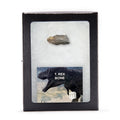Mosasaur Tooth Jewelry









Mosasaur Tooth Jewelry




































During the Cretaceous Period, while massive carnivores like Tyrannosaurus and Carcharodontosaurus ruled the land, another predator ruled the seas. Mosasaurs boasted flexible skulls and double-hinged jaws, allowing them to swallow prey whole, but the real danger was found in their dozens of sharp teeth. These teeth formed in a small cavity below a pre-existing tooth, allowing them to be continually replaced and letting the Mosasaur continually hunt.
This collection of Mosasaur jewelry features the aquatic predator's teeth set into earrings and pendants. Each tooth's root is sealed in sterling silver. The jewelry pieces come with a handsome display/storage box and a small information card that also serves as the certificate of authenticity.

📸 A medium mosasaur tooth pendant
Terror of the Cretaceous Seas
If we look first to the sea, the Mesozoic Era might not be known as the Age of Dinosaurs, but rather as the Age of Marine Reptiles. Beginning with the appearance of the dolphin-shaped Ichthyosaurs in the Triassic Period, the rising seas of the Jurassic Period gave way to a wider variety of large predators including the long-necked Plesiosaurs and Pliosaurs to the powerful Mosasaurs.
Since the first Mosasaur skull was discovered in 1764, our knowledge of this large family of marine reptiles has come primarily from skeletal remains. Mosasaurs ranged in size from 1.1m (3.3ft) to 17.4m (57 ft). Their skulls were flexible and their jaws were double-hinged. While this arrangement probably allowed a Mosasaur to swallow prey whole, the alignment of a Mosasaur's teeth with "bony crypts" to protect emerging teeth also suggests Mosasaurs likely crushed bones as frequently as they tore into flesh.

📸 Mosasaur tooth earrings
These jewelry items are crafted with beautiful Mosasaur tooth fossils. Both necklaces and earring pairs are available.
As you can see, the root of the tooth is sealed in sterling silver. All additional components of the jewelry are also sterling silver, including our standard 18" (45cm) box-style chain for necklaces. The bail is large enough to accommodate a heavier chain or cord for a more masculine appearance.
Both the necklaces and earrings come with a handsome display/storage box and a small information card that also serves as the certificate of authenticity.
Both small and medium necklaces are available, with small necklace teeth measuring >0.75" and medium necklaces measuring between 0.75" and 1". All earring teeth are approximately 0.75" long.
Please note: Color and shape vary to some degree but the sample shown here is representative of all specimens. Also, as with all Mosasaur teeth, there may be small cracks and other signs of repair in the enamel.

TEMPORAL RANGE: 92,000,000 to 66,000,000 years ago
MORE ABOUT MOSASAURS
"The mosasaur [...] was uniquely specialized to anchor large-sized teeth within powerful jaws..." ~ Min Liu, "Varanoid Tooth Eruption and Implantation Modes in a Late Cretaceous Mosasaur." (2016)

📸 A Mosasaur Tooth in Matrix at Mini Museum
The Shape of a Predator
Once thought to be almost crocodile-like in appearance or even related directly to snakes, recent studies have revised our understanding of Mosasaurs, giving way to a picture of a streamlined predator well-suited to dominating its environment.
While this evidence alone suggests the Mosasaurs were formidable predators, a spectacular new find in Jordan has revealed that Mosasaurs were "countershaded" with darker pigmentation on the top and lighter on the bottom. Similar soft tissue impressions show that Mosasaurs had tail flukes and true flippers. This new information suggests this already formidable predator could swim much faster than previously thought, a truly terrifying presence backed by a long history in the fossil record.

📸 A modern recreation of the Mosasaur

Front of the Specimen Card

Back of the Specimen Card

📸 ABOVE: A complete skeleton of Tylosaurus dyspelor, a large species of Mosasaur (1899).
Further Reading
Cope, Edward Drinker. "Lamarek Versus Weismann." Nature 41 (1889): 79.
Cope, Edward Drinker. The Primary Factors of Organic Evolution. Open Court, 1904.
Everhart, Michael J. Oceans of Kansas. Indiana University Press, 2005.
Lindgren, Johan, et al. "Convergent Evolution in Aquatic Tetrapods: Insights from an Exceptional Fossil Mosasaur." PLoS One 5.8 (2010): e11998.
Lindgren, Johan, et al. "Skin Pigmentation Provides Evidence of Convergent Melanism in Extinct Marine Reptiles." Nature (2014).
Liu, Min, et al. "Varanoid Tooth Eruption and Implantation Modes in a Late Cretaceous Mosasaur." Frontiers in Physiology 7 (2016).














































